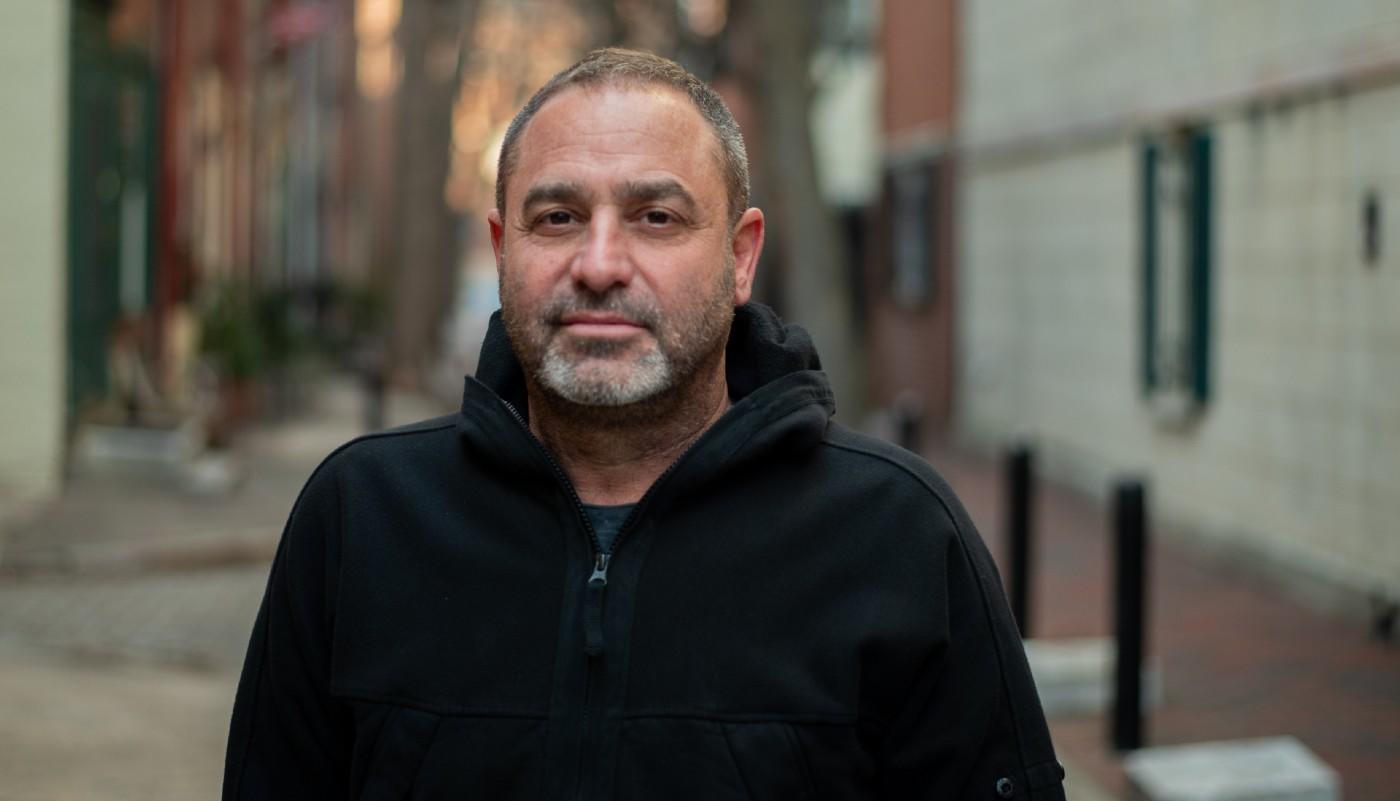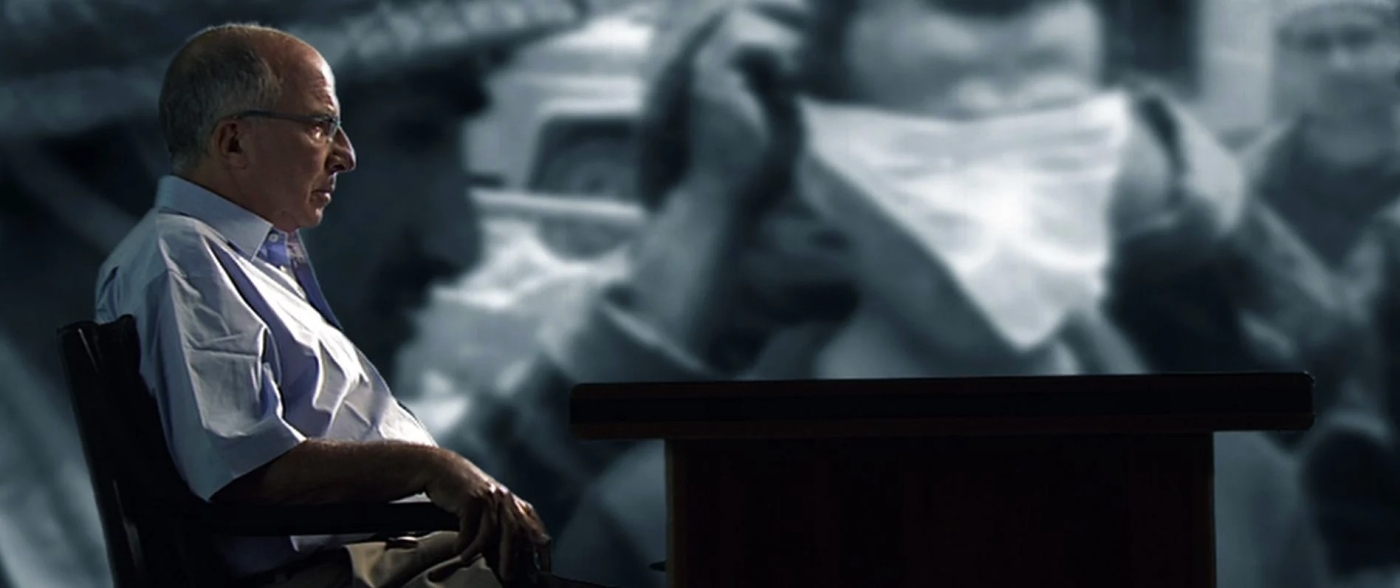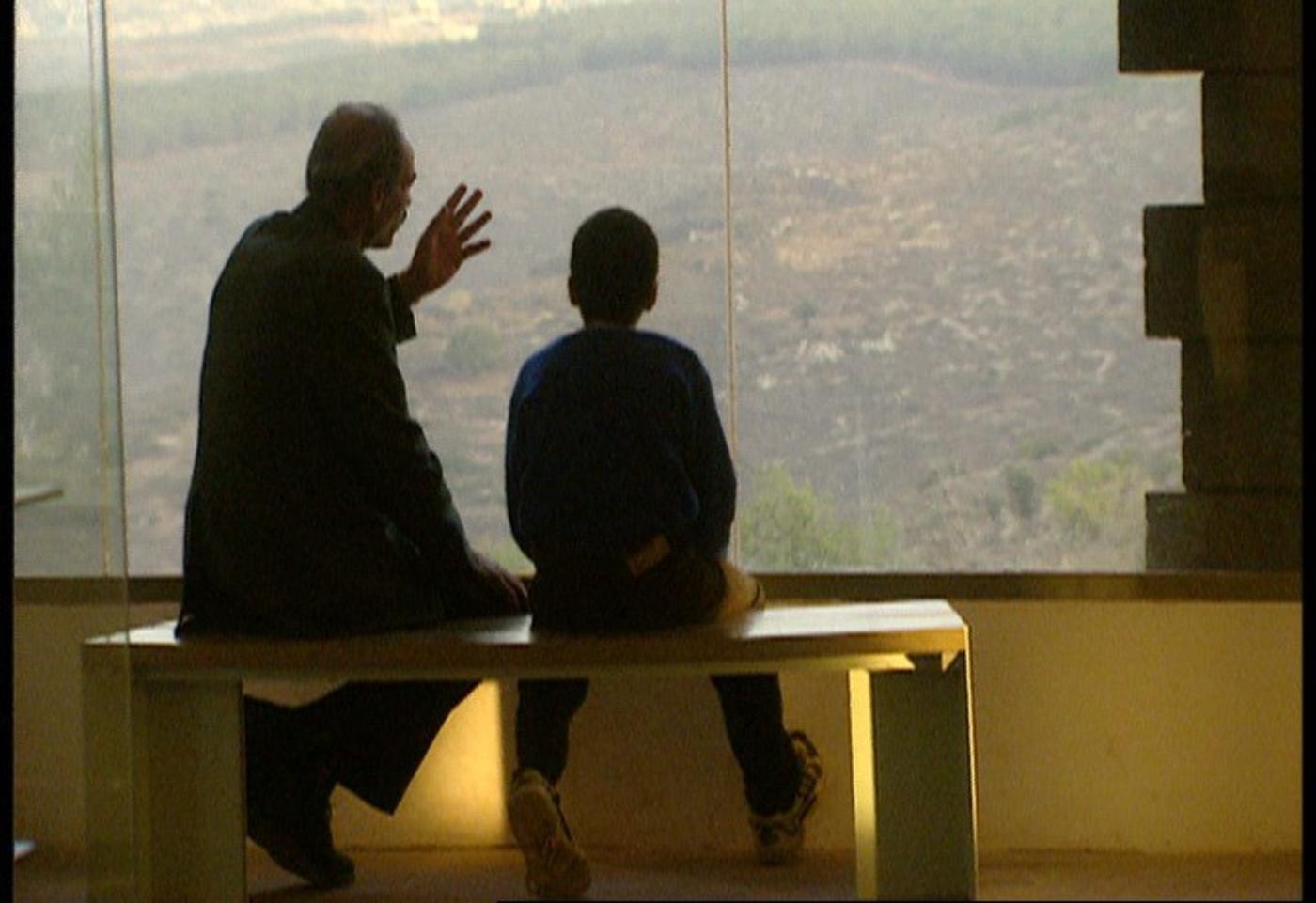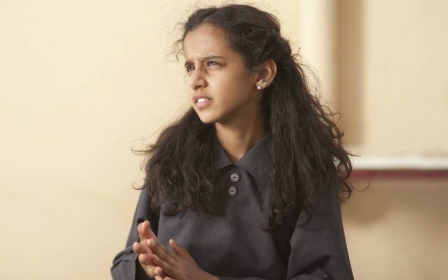'The Viewing Booth': Can Palestinian videos change the mind of pro-Israel student?

LOS ANGELES - It’s late 2017 at Temple University in Philadelphia. Maia Levy, a white, American college student, enters a small, dark screening room, which is dubbed “The Viewing Booth”. It’s been set up by Ra'anan Alexandrowicz, an Israeli filmmaker and graduate of the university.
“On the screen you have 40 videos from Israel,” he says, explaining that half are culled from right-wing, pro-Israel channels; the others, which take place in the West Bank city of Hebron, come from B’Tselem, a Palestinian watchdog which documents Israeli violations against Palestinians. “I’d like you to verbalise whatever comes to mind when you’re viewing. It can be things you know. It can be emotions. Basically any thought that you have.”
Alexandrowicz sits in the adjacent editing room and starts to quietly observe the Jewish-American student’s reactions and responses. His political views are kept under wraps, his personal comprehension of the images never revealed.
From the get-go, we learn that Levy is unabashedly pro-Israel. Her responses initially follow an expected line of thinking, giving direct interpretations of the images at hand. But gradually, she begins to question the authenticity behind the videos.
New MEE newsletter: Jerusalem Dispatch
Sign up to get the latest insights and analysis on Israel-Palestine, alongside Turkey Unpacked and other MEE newsletters
As her thoughts grow increasingly unpredictable, they impel the director to question the purpose and effectiveness of his previous work.
Life in pictures
The Viewing Booth is a fascinating, trailblazing experiment that investigates how we see and decode images, while simultaneously interrogating their veracity - or rather, in this post-structuralist world, if the image has any veracity. It screens at DOC NYC from 11 November until 19 November.
Born in Jerusalem in 1969, Alexandrowicz rose to fame in 2001 with The Inner Tour, his sophomore effort, a documentary that sees the director escort a group of Palestinians from the West Bank as they return to their homeland as tourists for the first time since the Nakba of 1948.
Co-produced by award-winning Palestinian director, Raed Andoni (Ghost Hunting), the documentary - which premiered at the Berlin Film Festival in 2001 - broke with tradition by acknowledging the Nakba, a major taboo that even the most, if not all, vocal and leftist of Israeli filmmakers tend to avoid.
The Inner Tour is the film closest to Alexandrowicz’s heart, yet speaking to Middle East Eye from Philadelphia, he stresses that he would never make a piece like that again.
“I realised that my camera should not be pointed at Palestinians. It’s Palestinian filmmakers who should do that,” he tells Middle East Eye. “The film has been criticised as exploitative in some circuits. When you make a film, you’re very much invested in the reasons for making it, so it took me time to acknowledge that criticism. After all, you are the occupier making a film about the occupied. And when you come from the powerful side and tackle injustice, you have to accept that the other side have the right to make their own assessment.”
A decade later, Alexandrowicz would deliver his most widely known work to date, The Law in These Parts, a highly provocative documentary tracing the drafting of Israeli laws made for the populations of Gaza and the West Bank following the Arab-Israeli War in 1967.
It is anchored from the viewpoint of retired judges and military men. Interjecting these interviews are archival footage culled from multiple media during the past half century “I wanted to show how it’s impossible to create something legal,” says Alexandrowicz, “these so-called laws, when the entire situation is illegal.”
Law is unapologetically fierce in underlying the blatant racist building blocks enacted by Israel’s elderly statesmen through their rule over Palestine. It also won the best international documentary award at the Sundance film festival in 2012, cementing Alexandrowicz’s reputation as one of cinema’s biggest critics of the Israeli government.
One overlooked element that this writer found exceptionally intriguing about The Law was how it demonstrated the self-admitted limitations of filmmaking in inferring a comprehensive truth. This limitation is augmented by the necessary act of editing, which chops up the details related to that truth - however accurate and comprehensive the director’s version may be. Early on, Alexandrowicz started to question the role of the factual image in this historical process. Are they simply observing the historical process? Are they part of the historical process?
“I fell into this rabbit hole,” he recalls. “I couldn’t find answers. I ultimately came to the conclusion that the answer may not necessarily be in the media or in the images. The answer perhaps is in the eyes that views the images.”
The film’s release sparked many discussions inside and outside Israel as to the illegality of its rule over Palestine. But as time went by, however, nothing changed.
“While the film was touring the world, screening on TV and seen by plenty of the people, the overall reality of Palestinians, on the other hand, kept getting worse and worse. I began to question the validity of the work I made before. And I then began to realise that if I continue to invest in making images, I need to investigate what people see in them. “
In subsequent years, Alexandrowicz has taken this idea, turned the camera around and filmed the act of viewing itself.
He embarked on different exercises, filming people first in cinemas, then in the home. The Viewing Booth resulted from of one of those experiments and was not initially pre-conceived as a film. “I didn’t think I was going to make a movie when I did that exercise that day,” says Alexandrowicz.
Maia takes centre stage
In 2017 Alexandrowicz put out an open call at Temple University. Seven people responded: Maia was not among them. Instead she texted Alexandrowicz in the middle of the day, stating that she had heard about the exercise and wanted to participate. One of the original respondents eventually couldn’t make it and so she filled in. “And then she became the movie.”
Alexandrowicz recalls how members of BAME groups, for example, saw different things from Maia in the images. “Who we are determines how we see images,” Alexandrowicz says.
He started editing the answers of the various respondents in parallel to one another. Soon, Alexandrowicz came to another conclusion: Maia was not representative of young, Jewish Americans. Maia was not representative of Jewish women. Maia was not representative of any group.
Instead, Maia was representative of the audience he had been making films for. “In my previous films, I had a certain audience in mind for whom I wanted to convey something for them see,” he says, “an audience who thinks differently than me.
“Maia’s politics are radically different from mine. At the same time, she’s a curious and critical viewer. She doesn’t shy away from images uncomfortable for her. In a nutshell, she is my ideal viewer.
As a consequence, Alexandrowicz decided to drop the parallel interviews and focus solely on Maia. While some critics may see a drawback in the lack of multiple perspectives, the concentration on one subject has resulted in a psychologically complex, multi-faceted portrait that may not have had the same impact had it been divided across multiple subjects.
At first, Maia shows sympathy for the the Palestinians as they are subjected to acts of cruelty: police night raid on a defenceless family; kids being kicked by Israeli soldiers and the like. But then she asks more questions. That raid looks staged, she claims; the kids may have provoked the soldiers into beating them up, she deduces. In one illuminating moment, Maia is shown footage of kids throwing stones at a residential building. She automatically assumes that the kids are Palestinians, only to learn that they are, in fact, Israelis.
Nor is Maia’s doubt restricted to the Palestinian footage; she instantly deems a clip of Israeli soldiers granting food to a Palestinian kid who goes and hugs him as fake (Alexandrowicz actually believes it isn’t). But overall, her sentiment remains staunchly pro-Israeli.
The B’Tselem footage proves to be of no importance to her whatsoever. By the end of The Viewing Booth, after she’s invited back to watch herself watching the footage, Maia delivers the ultimate killer blow: “Maybe when we question what we see, it reinforces what we believe in,” she says. “Maybe B'Tselem is actually helping me.”
The morality of images
In 2011, in her essay Getting Rid Of The Distinction Between The Aesthetic And The Political, curator and theorist Ariella Azoulay wrote about what she dubs “the civil gaze”. In it, she advocates the ethical necessity of seeing images as they are, instead of basing perception on elements lying outside the visible context of the frame. Writer Virginia Woolf similarly stated that suffering will not stop before “when we look at the same photographs, we will feel the same things”.
In The Viewing Booth, the act of seeing, of processing, of interpreting images, becomes a moral conundrum: a constant struggle to defend oneself against the possible duplicity of the image. At the same time one has to acknowledge the various personal filters - political, social, religious - that obstruct us from seeing an image with a clear, unbiased eye; for uncovering the sheer universal humanity ingrained in the image.
The Inner Tour was gorgeously lensed: Alexandrowicz states that it “drips with love for the land”. In contrast The Viewing Booth is an intentionally contrasting proposition, set in darkly-lit space, focused on a single character and with not a hint of narrative. The openness of the structure and the lack of story grants the audience the space to perceive the material in any way they want.
Alexandrowicz has previously credited new technology for “destabilizing the power dynamics, highlighting the asymmetrical relation of state power and the citizens they are meant to serve”.
In the Israeli-Palestinian context, he believes that Palestinians have become empowered through mobile camera phones and online video sharing, thereby transforming their position “from being the subjects of documentation to them documenting themselves”.
With the advent of YouTube and similar online digital services during the past two decades, B’Tselem began to distribute dozens of cameras to the Palestinian residents of the West Bank. They then produced small clips - or what Alexandrowicz dubs “documentary fragments” - that could be seen by a far wider audience than for documentary features like The Law in These Parts.
Through this, the violations committed against Palestinians by the Israeli state and associated parties have been more extensively documented during the past decade than at any other time in history. Yet can images still manage to hold any power, given the increasing ubiquity of visuals across media?
“I don’t agree that images are powerless,” says Alexandrowicz. “I mean, look at what happened with George Floyd. I do, however, admit there’s a great and rapid evolution in the making of non-fiction image-making and I can no longer follow the same paradigms that governed how I made documentaries before.”
Despite Maia’s final dismissive stance, Alexandrowicz was quite hopeful. “When we presented the film to the residents of Hebron who filmed these images, they were very optimistic about Maia,” he said. They’ve heard all of these doubts before; they live with these doubts. But they saw in her engagement with the images and how she’s trying to fight them, a manifestation of the power of their images.
“Maia reflects something in all of us, with all our different political stances. I hope people seeing her would start pondering how they watch images. Are they projecting themselves on what they’re seeing and by default change these images to fit their worldview?”
One unavoidable aspect associated with the use of images in 202o is their widespread manipulation. We’re at the ultimate peak of photoshopping, dozens of years away from when light fell onto film to create an indelible truth.
In this day and age, the veracity of the image has become all the more elusive. Additionally the average viewer sees images in structures that contextualise them and gives them meaning. To see images as they fundamentally are is a faculty most viewers no longer possess.
Alexandrowicz agrees.
“The fundamental dilemma we’re facing now relates to the narration of the non-fiction image, and by narration I mean the various tools used to guide the viewers into believing a specific truth conveyed by the filmmakers, and it’s often done by making them resemble fiction films.
'A picture is worth a thousand words' now feels like the product of a bygone past
“Someone once said that ‘the image cannot lie, but you can lie with the image.’ That’s the situation we’re in right now with documentary filmmaking. I often find myself when watching documentaries questioning their making, doubting various aspects presented as truth in them. Narration pollutes the images, forcing spectators like Maia to doubt something as basic and pure as the B’Tselem videos, which I believe to be utterly ingenuous. The real challenge we’re facing now is getting back to the truth behind the raw, unmanipulated images.”
“We’re at a place of inherit doubt in the image. And the question we’re facing now is how can we maintain the integrity of the non-fiction image,” Alexandrowicz says. “We’re currently stuck in the directionality of the image. As it stands, we still have people making images and they expect people to consume these images and believe in whichever discourse they’re promoting.
"With The Viewing Booth, I’m attempting to envision if there’s a way to create a dialogue; for the spectators to question these images and to have the image-makers answer them in a fashion that does not fall into the binary guiding principles of believing and not believing.”
As such, Alexandrowicz does not believe he can go back to making straightforward non-fiction films. “It’s like when you first start to learn to walk; if you overthink the procedure, putting one foot after the other, you will stumble. My main concern now is to understand the relationship between the image and society; the image and the viewers. This is where I will be dwelling for the time being.”
The Viewing Booth screens at DOC NYC from 11 November until 19 November.
Middle East Eye delivers independent and unrivalled coverage and analysis of the Middle East, North Africa and beyond. To learn more about republishing this content and the associated fees, please fill out this form. More about MEE can be found here.








